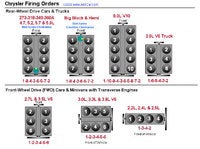piston firing order
2 Answers
The firing order of an engine is the sequence the spark plugs fire. On engines with a distributor, the firing order is determined by the routing of the spark plug wires from the distributor cap to the spark plugs in each cylinder. When the piston is at top dead center (TDC) on the compression stroke, the rotor inside the distributor should be aligned with the number one (#1) spark plug terminal in the distributor cap. Most (but not all) Ford distributors rotate in a counter-clockwise direction, so the next plug wire in the cap would go to the next spark plug in the firing sequence for that engine. On most Chrysler engines the #1 cylinder is the first cylinder at the front of the engine on the driver side (left side) of a rear-wheel drive car or truck. On front-wheel drive cars and minivans with 2.7L and 3.5L V6 engines, the #1 cylinder is the first cylinder on the front RIGHT side of the engine. On trucks with the 3.9L V6, #1 cylinder is the first cylinder at the front LEFT of the engine. The cylinders are numbered in a staggered sequence, with all the odd numbers on one side and the even numbers on the other side. The correct firing order is very important because mixing up the spark plug wires may prevent the engine from starting, cause it to backfire and run very poorly if at all. On engines with distributorless ignition systems or coil-on-plug ignition systems, the firing order is controlled by the ignition module or engine computer. The computer receives an input signal from the crankshaft position sensor (and camshaft position sensor on some engines) to determine which piston is coming up to top dead center on its compression stroke. It then fires that spark plug, and the next and so on in the firing sequence.
